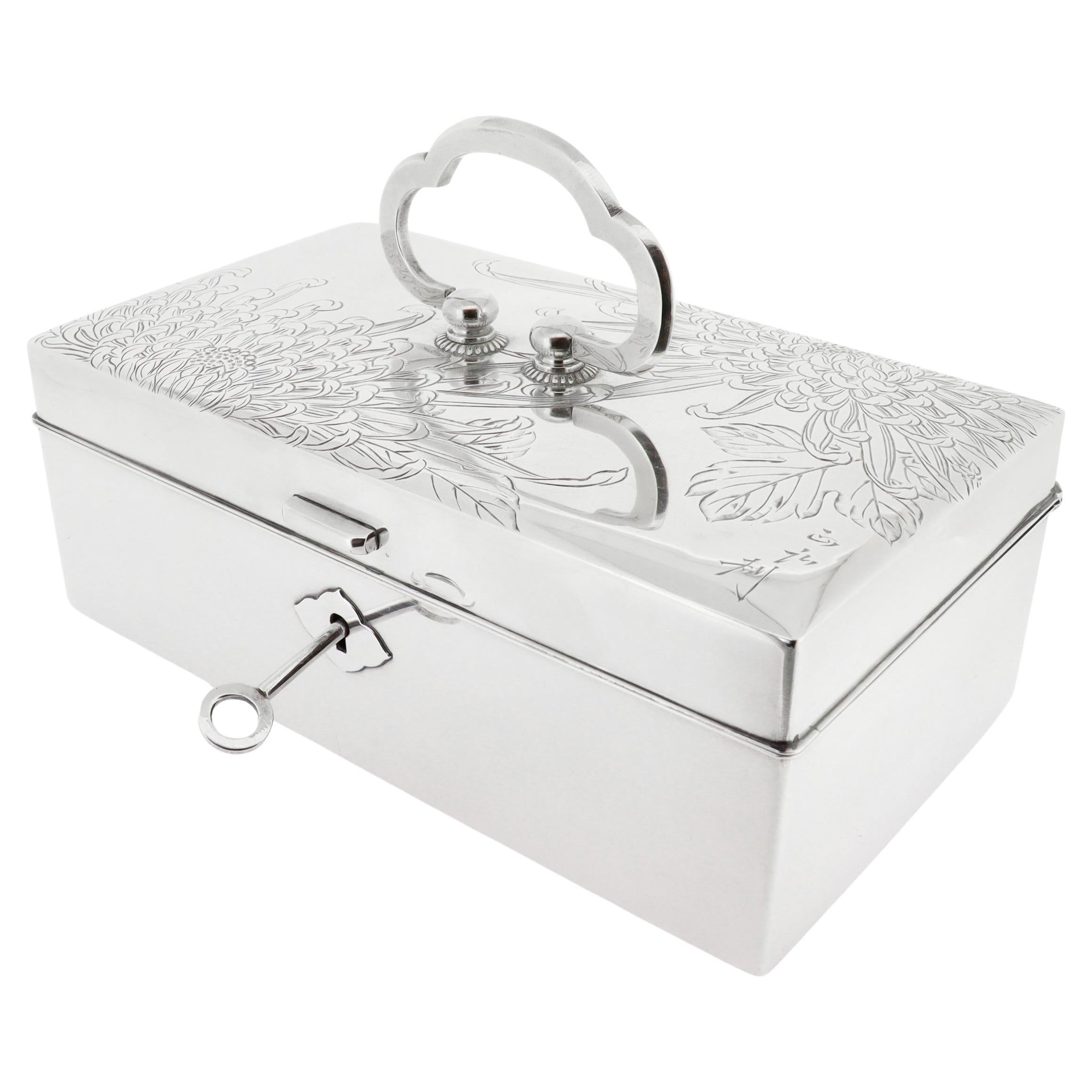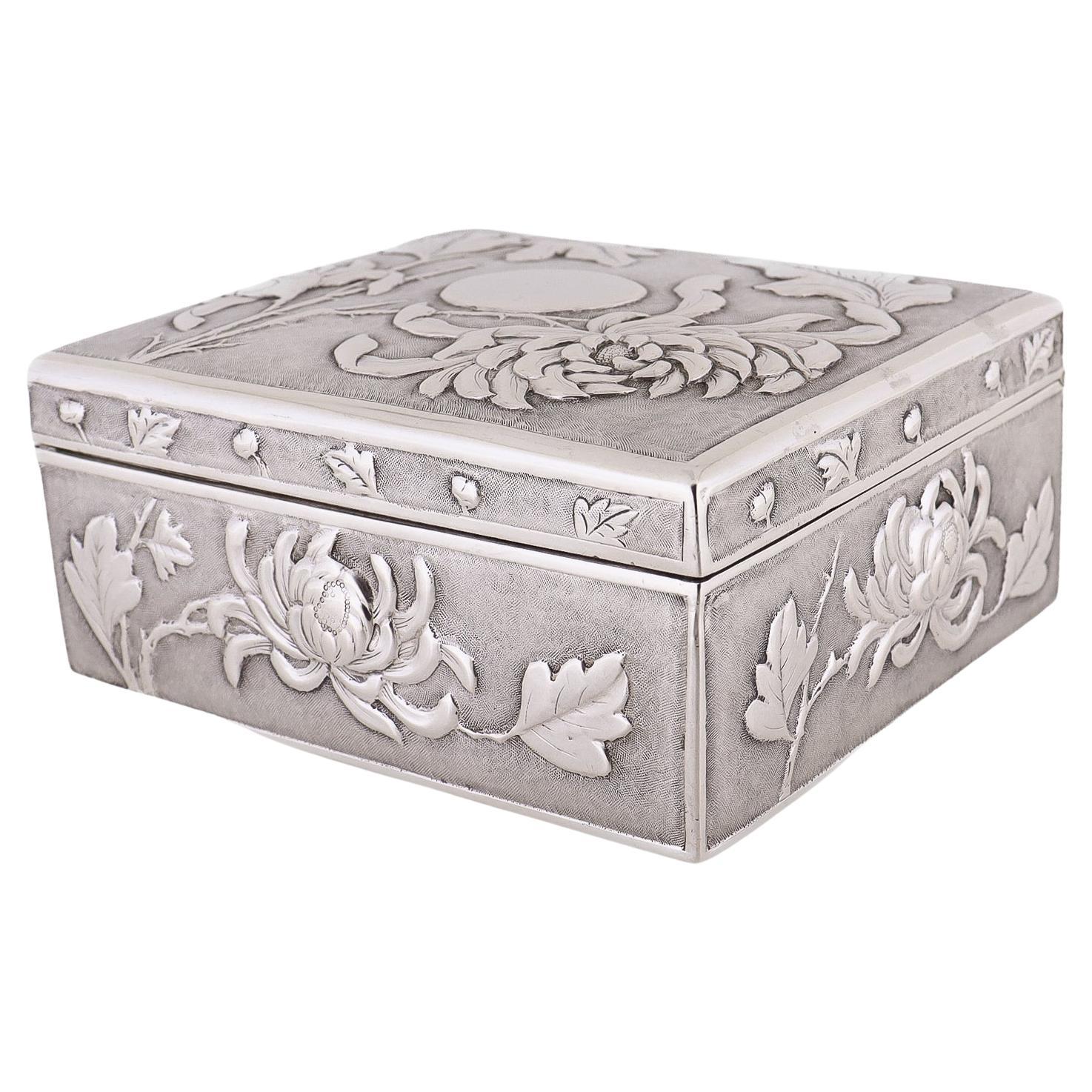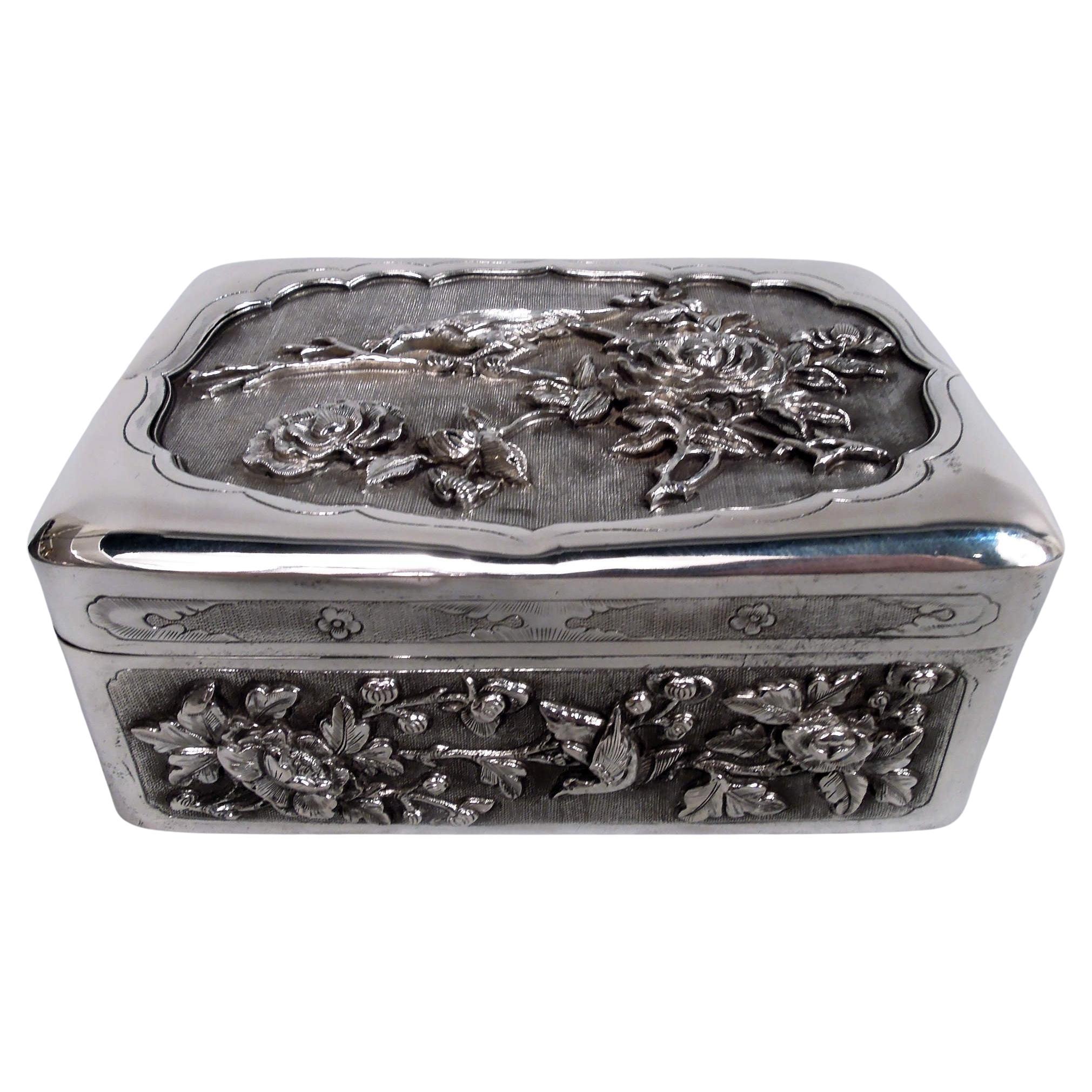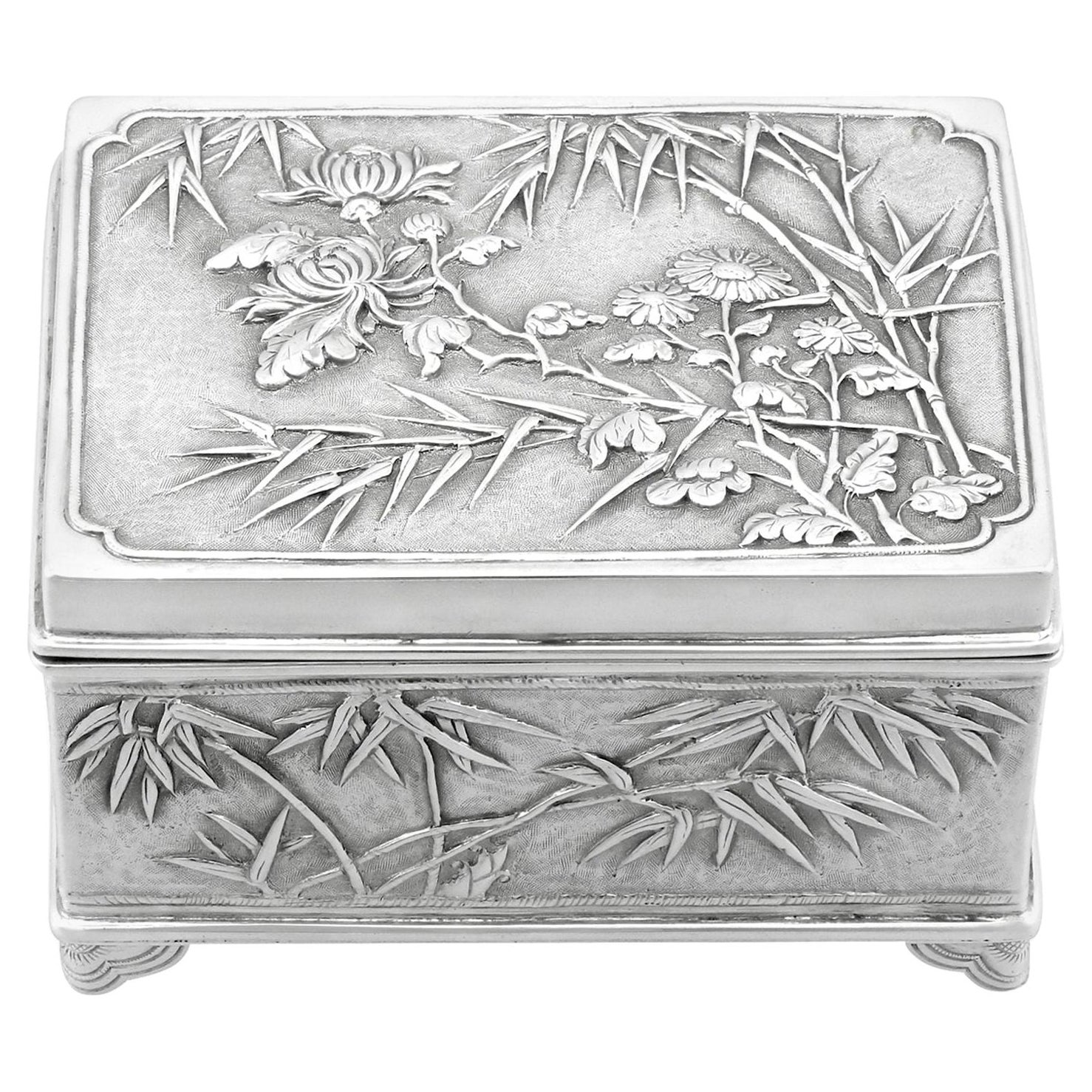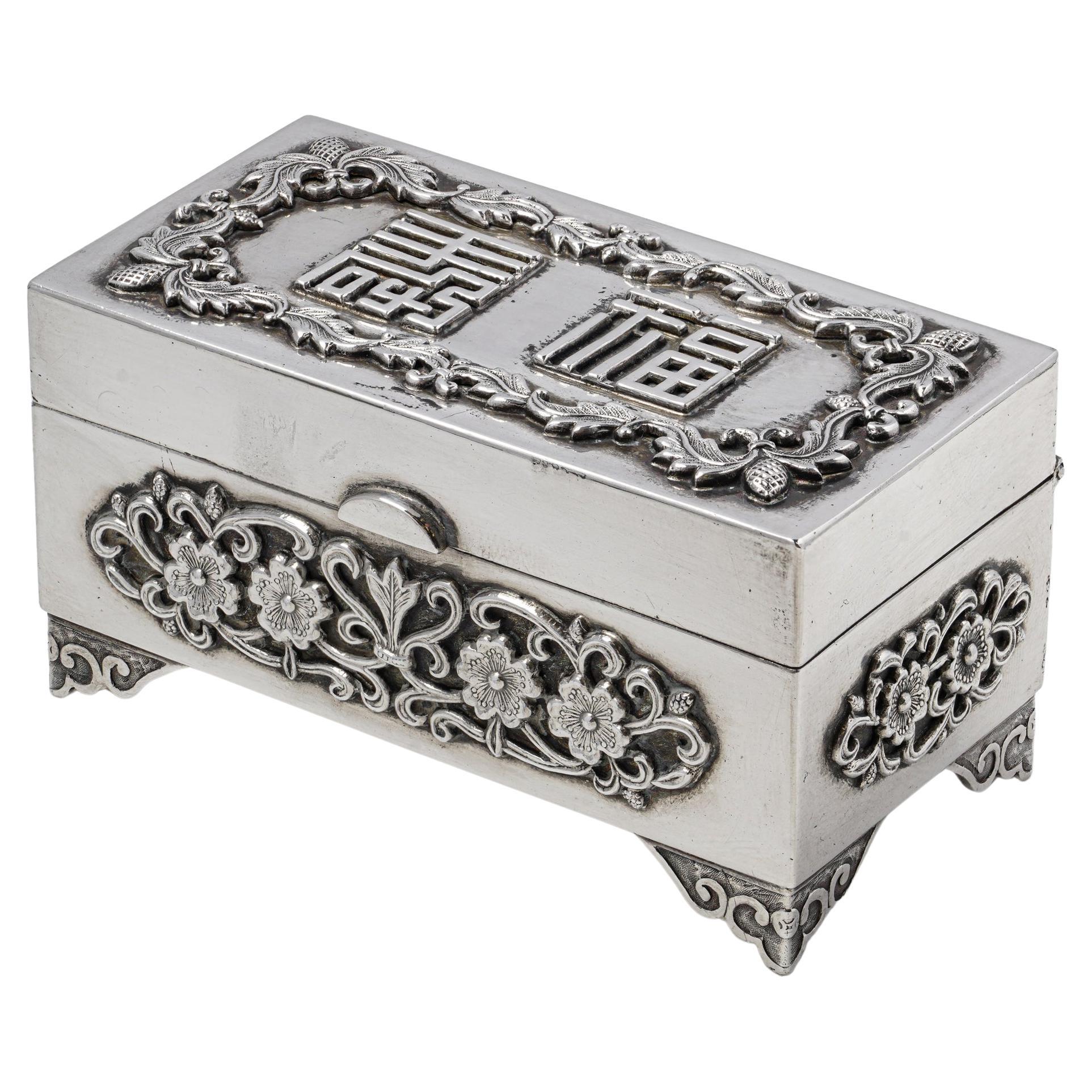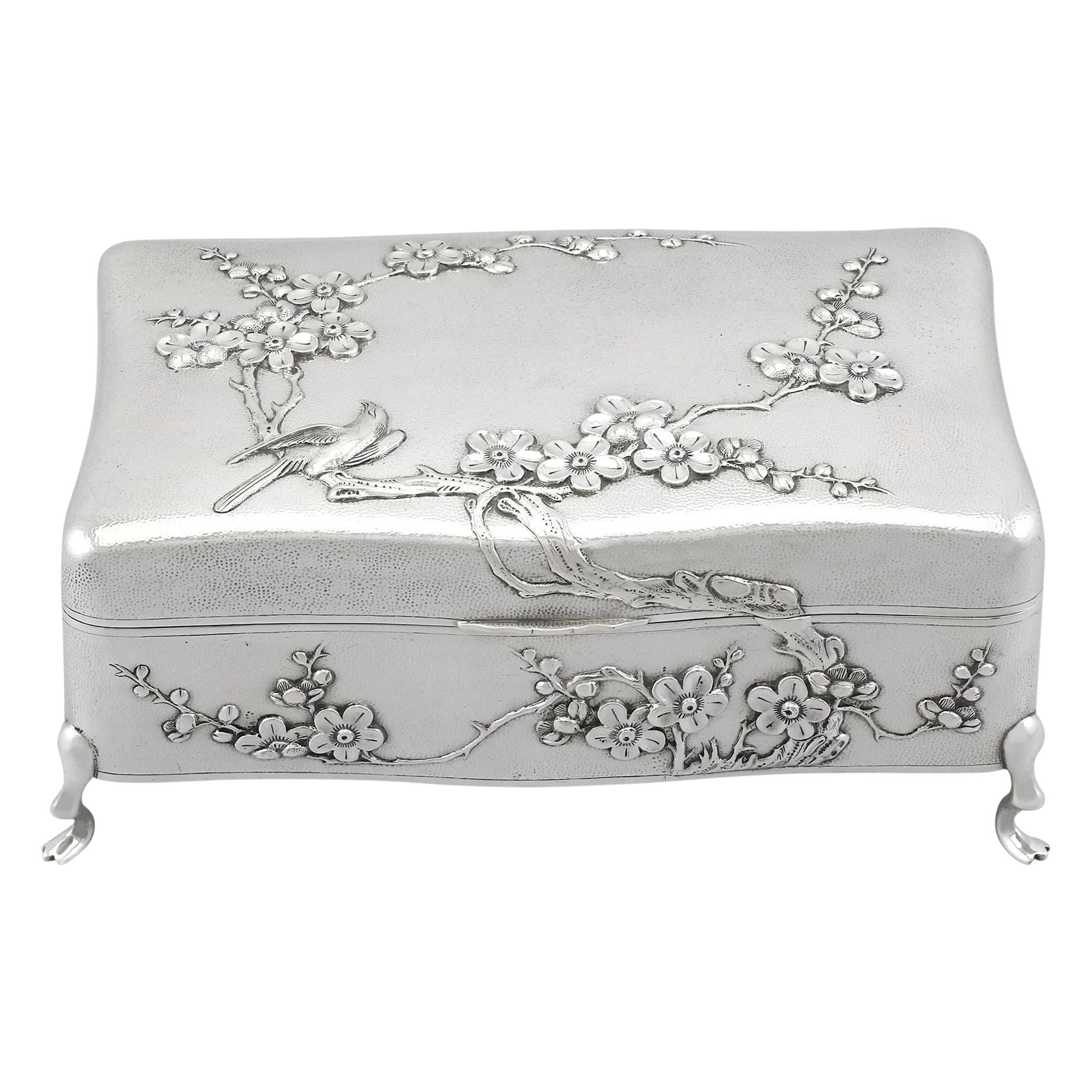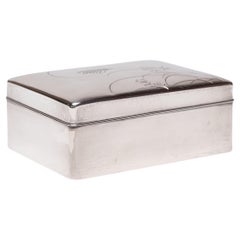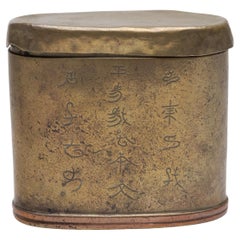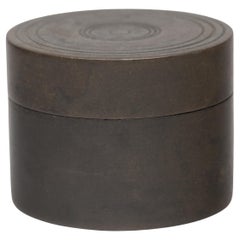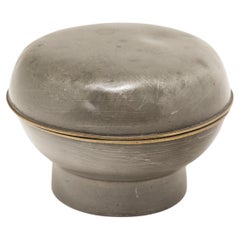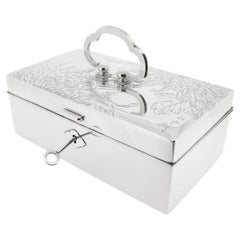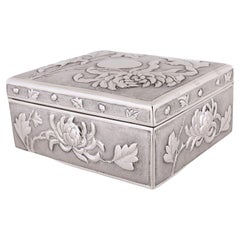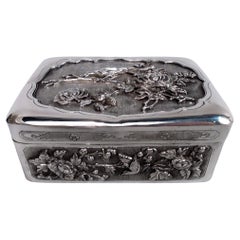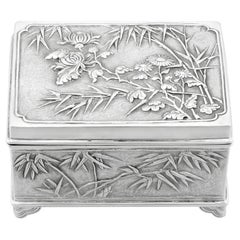Items Similar to Japanese Enameled Silver Chrysanthemum Box
Want more images or videos?
Request additional images or videos from the seller
1 of 6
Japanese Enameled Silver Chrysanthemum Box
$1,280
£971.93
€1,111.48
CA$1,788.35
A$1,989.03
CHF 1,038.61
MX$24,204.39
NOK 13,264.63
SEK 12,439.89
DKK 8,295.40
Shipping
Retrieving quote...The 1stDibs Promise:
Authenticity Guarantee,
Money-Back Guarantee,
24-Hour Cancellation
About the Item
This lovely silver box exemplifies Japanese refinement in all crafts. The petite bonbonnière is formed of high quality silver with a rectangular cartouche form and a removable lid. The lid is decorated in low relief with a spray of enameled chrysanthemum blossoms, a symbol of autumn. Above the flowers is the kamon (family crest) of the Shimazu family. The underside of the box is stamped with a makers mark for Miyamoto zo and a mark indicating "Pure Silver."
- Dimensions:Height: 1 in (2.54 cm)Width: 2.25 in (5.72 cm)Depth: 1.75 in (4.45 cm)
- Materials and Techniques:Silver,Enameled
- Place of Origin:
- Period:
- Date of Manufacture:20th Century
- Condition:Wear consistent with age and use.
- Seller Location:Chicago, IL
- Reference Number:Seller: AHF0021B1stDibs: LU820042819692
About the Seller
5.0
Platinum Seller
Premium sellers with a 4.7+ rating and 24-hour response times
Established in 1997
1stDibs seller since 2006
1,695 sales on 1stDibs
Typical response time: 1 hour
- ShippingRetrieving quote...Shipping from: Chicago, IL
- Return Policy
Authenticity Guarantee
In the unlikely event there’s an issue with an item’s authenticity, contact us within 1 year for a full refund. DetailsMoney-Back Guarantee
If your item is not as described, is damaged in transit, or does not arrive, contact us within 7 days for a full refund. Details24-Hour Cancellation
You have a 24-hour grace period in which to reconsider your purchase, with no questions asked.Vetted Professional Sellers
Our world-class sellers must adhere to strict standards for service and quality, maintaining the integrity of our listings.Price-Match Guarantee
If you find that a seller listed the same item for a lower price elsewhere, we’ll match it.Trusted Global Delivery
Our best-in-class carrier network provides specialized shipping options worldwide, including custom delivery.More From This Seller
View AllJapanese Silver Trinket Box with Full Moon & Grass, c. 1900
Located in Chicago, IL
This Meiji-period trinket box exemplifies Japanese refinement in all crafts. Fashioned of silver with a hardwood interior, the small box has a clean-lined rectangular form with rounded corners and a thin lip where the lid meets the base. The lid is etched with tall grasses swaying before a full moon, a motif that represents the Japanese moon...
Category
Antique Late 19th Century Japanese Minimalist Decorative Boxes
Materials
Silver
Etched Chinese Opium Box, c. 1850
Located in Chicago, IL
A small brass canister once used to store a smoker's personal supply of opium paste. A keepsake from a bygone era, the small box dates to the 19th century and is decorated with etchi...
Category
Antique 19th Century Chinese Qing Metalwork
Materials
Brass, Copper
Chinese Bronze Opium Box, c. 1900
Located in Chicago, IL
A petite bronze canister once used to store a smoker's personal supply of opium paste. A keepsake from a bygone era, the small box dates to the early 20th century and provided an air...
Category
Early 20th Century Chinese Qing More Asian Art, Objects and Furniture
Materials
Bronze
Chinese Pewter Trinket Dish, c. 1920
Located in Chicago, IL
For one short decade, from around 1910 to 1920, pewter was all the rage in China’s bustling commercial centers of Shanghai and Canton. Drawn to pewter’s soft, silvery glow, artists t...
Category
Early 20th Century Chinese Metalwork
Materials
Brass, Pewter
Petite Oval Opium Box, c. 1900
Located in Chicago, IL
A petite 19th-century canister once used to store a smoker's personal supply of opium paste. Perfecting line and form, the small box has a balanced, oval form shaped of white brass (...
Category
Early 20th Century Chinese Minimalist Decorative Boxes
Materials
Brass, Copper
English Petite Mother-of-Pearl Inlay Box, c. 1900
Located in Chicago, IL
This late 19th century English trinket box has an elegant design of lacquered papier-mâché with mother-of-pearl inlay. The inlaid decoration depicts a spray of various flowers which ...
Category
Antique Late 19th Century British Victorian Snuff Boxes and Tobacco Boxes
Materials
Mother-of-Pearl, Wood, Lacquer
You May Also Like
Signed Japanese 950 Sterling Silver Handled Jewelry Box with Chrysanthemums
Located in Philadelphia, PA
A fine signed Japanese silver jewelry box.
In .950 sterling silver.
With intricate engraved chrysanthemum decoration and a trefoil handle to the lid.
The interior with a lacquered...
Category
20th Century Japanese Boxes and Cases
Materials
Sterling Silver
Antique Chinese Export Silver Box with Repousse Chrysanthemums by Zee Wo
Located in Philadelphia, PA
A fine antique Chinese export silver box.
By Zee Wo of Shanghai, China.
Decorated throughout with repousse chrysanthemums on a stippled ground.
The lid with an unengraved cartouc...
Category
Early 20th Century Chinese Boxes and Cases
Materials
Silver
Antique Japanese Meiji Silver Box with Birds & Blossoming Branches
Located in New York, NY
Japanese Meiji silver box, ca 1890. Rectangular with curved corners. Box sides have chased and engraved birds amidst blossoming branches and bamboo in rectangular frames. Cover top h...
Category
Antique Late 19th Century Japanese Meiji Decorative Boxes
Materials
Silver
1900s Antique Chinese Export Silver Box
By Luen Hing
Located in Jesmond, Newcastle Upon Tyne
An exceptional, fine and impressive antique Chinese export silver box; an addition to our range of silver boxes and cases
This exceptional antique Chinese Silver box...
Category
Antique Early 1900s Chinese Sterling Silver
Materials
Sterling Silver
Chinese Silver Decorative Box with Relief Floral Motif and Red Velvet Interior
Located in Braintree, GB
A charming and finely crafted Chinese silver box, designed with ornate floral relief patterns on the exterior and intricate scrollwork along the sides and base. Featuring a hinged li...
Category
Mid-20th Century Sterling Silver
Materials
Silver
Antique Chinese Export Silver Jewelry Box
By Hung Chong & Co.
Located in Jesmond, Newcastle Upon Tyne
An exceptional, fine and impressive antique Chinese Export silver jewellery box; an addition to our collection of boxes and cases
This exceptional antique Chinese Export Silver box has a subtly undulating rectangular form.
The surface of the box has a planished finish and is embellished with an embossed and chased decorated stemmed floral and foliate design to the anterior surface.
The decoration to the body continues to the cover, incorporating plum blossom arrangements and an impressive perched bird motif.
This antique jewellery box is fitted with the original hinged cover.
This exceptional Chinese silver jewellery box is supported by four impressive cast silver feet.
The hallmarks struck to the underside of this fine box include:
Maker's mark: HC (Hung Chong)
Artisan workshop mark: QI CHANG (Shanghai)
NOTE: We are grateful to Adrien von Ferscht for his help in identifying this exceptional antique piece.
Condition
This antique Chinese silver jewellery...
Category
Antique 1890s Chinese Jewelry Boxes
Materials
Silver
More Ways To Browse
Japanese Enamel
Vintage Japanese Flower Art
Silver Box Japan
Japanese Silver And Enamel
Japanese Maker Marks
Japanese Enamel Box
Bonbonnieres
Enamel Bonbonniere
Japanese Bronze Dog
Japanese Copper Tea
Middle Eastern Coffee Pots
Bronze Censor
Cloisonne Tray
Copper Incense Burner
Large Chinese Dragons Brass
Koro Bronze
Meiji Plaque
Shang Bronze
